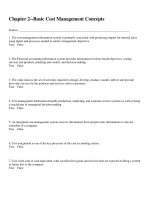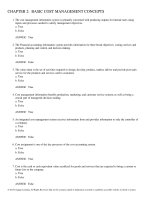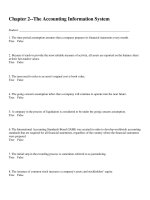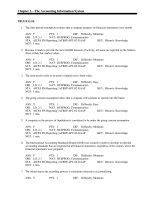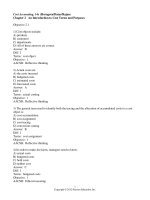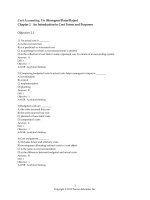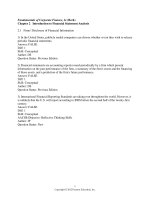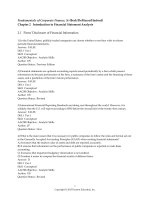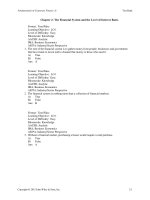Fundamentals of cost accounting 5th edition lanen test bank
Bạn đang xem bản rút gọn của tài liệu. Xem và tải ngay bản đầy đủ của tài liệu tại đây (1.13 MB, 312 trang )
Chapter 02
Cost Concepts and Behavior
True / False Questions
1. The cost of an item is the sacrifice of resources made to acquire it.
True
False
2. An expense is a cost charged against revenue in an accounting period.
True
False
3. If a cost is recorded as an asset (for example, prepaid rent for an office building), it becomes an
expense when the asset has been consumed.
True
False
4. Accounting systems typically record opportunity costs as assets and treat them as intangible
items on the financial statements.
True
False
5. Total cost of goods purchased minus beginning merchandise inventory plus ending merchandise
inventory equals cost of goods sold.
True
False
2-1
Copyright © 2017 McGraw-Hill Education. All rights reserved. No reproduction or distribution without the prior written consent of
McGraw-Hill Education.
6. Cost of goods sold includes the actual costs of the goods sold and the costs required to sell them
to the customer.
True
False
7. Period costs are those costs assigned to units of production in the period in which they are
incurred.
True
False
8. Only direct costs can be classified as product costs; indirect costs are classified as period costs.
True
False
9. The three categories of product costs are direct materials, direct labor, and manufacturing
overhead.
True
False
10. The first step in determining whether a cost is direct or indirect is to specify the cost allocation
rule.
True
False
11. Total work-in-process during the period is the sum of the beginning work-in-process inventory and
the total manufacturing costs incurred during the period.
True
False
2-2
Copyright © 2017 McGraw-Hill Education. All rights reserved. No reproduction or distribution without the prior written consent of
McGraw-Hill Education.
12. Cost of goods sold plus the ending finished goods inventory minus the beginning finished goods
inventory equals the cost of goods manufactured.
True
False
13. If the cost of goods manufactured during the period exceeds the cost of goods sold, the ending
balance of Finished Goods Inventory account increased.
True
False
14. Total variable costs change inversely with changes in the volume of activity.
True
False
15. Fixed costs per unit change inversely with changes in the volume of activity.
True
False
16. The range within which fixed costs remain constant as volume of activity varies is known as the
relevant range.
True
False
17. The term full cost refers to the cost of manufacturing and selling a unit of product and includes
both fixed and variable costs.
True
False
18. Variable marketing and administrative costs are included in determining full absorption costs.
True
False
2-3
Copyright © 2017 McGraw-Hill Education. All rights reserved. No reproduction or distribution without the prior written consent of
McGraw-Hill Education.
19. Revenue minus cost of goods sold equals contribution margin.
True
False
20. The primary goal of the cost accounting system is to provide managers with information to
prepare their annual financial statements.
True
False
Multiple Choice Questions
21. An opportunity cost is
A. a cost that is charged against revenue in an accounting period.
B. the foregone benefit from the best alternative course of action.
C. the excess of operating revenues over operating costs.
D. the cost assigned to the products sold during the period.
22. Which of the following statements is (are) true?
(1). An asset is a cost that will be matched with revenues in a future accounting period.
(2). Opportunity costs are recorded as intangible assets in the current accounting period.
A. Only (1) is true.
B. Only (2) is true.
C. Both (1) and (2) are true.
D. Neither (1) nor (2) are true.
2-4
Copyright © 2017 McGraw-Hill Education. All rights reserved. No reproduction or distribution without the prior written consent of
McGraw-Hill Education.
23. Which of the following statements is (are) false?
(1). In general, the term expense is used for managerial purposes, while the term cost refers to
external financial reports.
(2). An opportunity cost is the benefit forgone by selecting one alternative over another.
A. Only (1) is false.
B. Only (2) is false.
C. Both (1) and (2) are false.
D. Neither (1) nor (2) are false.
24. Which of the following best distinguishes an opportunity cost from an outlay cost?
A. Opportunity costs are recorded, whereas outlay costs are not.
B. Outlay costs are speculative in nature, whereas opportunity costs are easily traceable to
products.
C. Opportunity costs have very little utility in practical applications, whereas outlay costs are
always relevant.
D. Opportunity costs are sacrifices from foregone alternative uses of resources, whereas outlay
costs are cash outflows.
25. Which of the following accounts would be a period cost rather than a product cost?
A. Depreciation on manufacturing machinery.
B. Maintenance on factory machines.
C. Production manager's salary.
D. Freight out.
2-5
Copyright © 2017 McGraw-Hill Education. All rights reserved. No reproduction or distribution without the prior written consent of
McGraw-Hill Education.
26. A company which manufactures custom-made machinery routinely incurs sizable telephone costs
in the process of taking sales orders from customers. Which of the following is a proper
classification of this cost?
A. Product cost
B. Period cost
C. Conversion cost
D. Prime cost
27. For a manufacturing company, which of the following is an example of a period cost rather than a
product cost?
A. Wages of salespersons.
B. Salaries of machine operators.
C. Insurance on factory equipment.
D. Depreciation of factory equipment.
28. Tallon Company manufactures a single product. The product's prime costs consist of
A. direct material and direct labor.
B. direct material and factory overhead.
C. direct labor and factory overhead.
D. direct material, direct labor and factory overhead.
2-6
Copyright © 2017 McGraw-Hill Education. All rights reserved. No reproduction or distribution without the prior written consent of
McGraw-Hill Education.
29. The cost of fire insurance for a manufacturing plant is generally considered to be a:
A. product cost.
B. period cost.
C. variable cost.
D. all of these.
30. An example of a period cost is:
A. fire insurance on a factory building.
B. salary of a factory supervisor.
C. direct materials.
D. rent on a headquarters building.
31. Transportation costs incurred by a manufacturing company to ship its product to its customers
would be classified as which of the following?
A. Product cost
B. Manufacturing overhead
C. Period cost
D. Administrative cost
2-7
Copyright © 2017 McGraw-Hill Education. All rights reserved. No reproduction or distribution without the prior written consent of
McGraw-Hill Education.
32. Doran Technical Company has set up a toll-free telephone line for customer inquiries regarding
computer hardware produced by the company. The cost of this toll-free line would be classified as
which of the following?
A. Product cost
B. Manufacturing overhead
C. Direct labor
D. Period cost
33. Which of the following costs is both a prime cost and a conversion cost?
A. direct materials
B. direct labor
C. manufacturing overhead
D. administrative costs
34. Marketing costs include all of the following except:
A. Advertising.
B. Shipping costs.
C. Sales commissions.
D. Legal and accounting fees.
2-8
Copyright © 2017 McGraw-Hill Education. All rights reserved. No reproduction or distribution without the prior written consent of
McGraw-Hill Education.
35. Property taxes on the manufacturing facility are an element of
Conversion Cost
Period Cost
a.
No
No
b.
No
Yes
c.
Yes
No
d.
Yes
Yes
A. Option A
B. Option B
C. Option C
D. Option D
36. The cost of the direct labor will be treated as an expense on the income statement when the
resulting:
A. payroll costs are paid.
B. payroll costs are incurred.
C. products are completed.
D. products are sold.
2-9
Copyright © 2017 McGraw-Hill Education. All rights reserved. No reproduction or distribution without the prior written consent of
McGraw-Hill Education.
37. Calculate the conversion costs from the following information:
Fixed manufacturing overhead
$2,000
Variable manufacturing overhead
1,000
Direct materials
2,500
Direct labor
1,500
A. $3,000
B. $4,000
C. $4,500
D. $5,000
38. The corporate controller's salary would be considered a(n):
A. manufacturing cost.
B. product cost.
C. administrative cost.
D. selling expense.
2-10
Copyright © 2017 McGraw-Hill Education. All rights reserved. No reproduction or distribution without the prior written consent of
McGraw-Hill Education.
39. The costs of direct materials are classified as:
Conversion cost Manufacturing cost Prime cost
A)
Yes
Yes
Yes
B)
No
No
No
C)
Yes
Yes
No
D)
No
Yes
Yes
A. Choice A
B. Choice B
C. Choice C
D. Choice D
2-11
Copyright © 2017 McGraw-Hill Education. All rights reserved. No reproduction or distribution without the prior written consent of
McGraw-Hill Education.
40. Grover Company has the following data for the production and sale of 2,000 units.
Sales price per unit
$800 per unit
Fixed costs:
Marketing and administrative
$400,000 per period
Manufacturing overhead
$200,000 per period
Variable costs:
Marketing and administrative
$50 per unit
Manufacturing overhead
$80 per unit
Direct labor
$100 per unit
Direct Materials
$200 per unit
What is the conversion cost per unit?
A. $100
B. $180
C. $280
D. $380
2-12
Copyright © 2017 McGraw-Hill Education. All rights reserved. No reproduction or distribution without the prior written consent of
McGraw-Hill Education.
41. Grover Company has the following data for the production and sale of 2,000 units.
Sales price per unit
$800 per unit
Fixed costs:
Marketing and administrative
$400,000 per period
Manufacturing overhead
$200,000 per period
Variable costs:
Marketing and administrative
$50 per unit
Manufacturing overhead
$80 per unit
Direct labor
$100 per unit
Direct Materials
$200 per unit
What is the prime cost per unit?
A. $100
B. $280
C. $300
D. $480
42. Which one of the following costs is classified as a period cost? (CIA adapted)
A. The wages of the workers on the shipping docks who load completed products onto outgoing
trucks.
B. The wages of a worker paid for idle time resulting from a machine breakdown in the molding
department.
C. The payments for employee (fringe) benefits paid on behalf of the workers in the
manufacturing plant.
D. The wages paid to workers for reworking defective products that failed the quality inspection
upon completion.
2-13
Copyright © 2017 McGraw-Hill Education. All rights reserved. No reproduction or distribution without the prior written consent of
McGraw-Hill Education.
43. The following cost data for the month of May were taken from the records of the Terrence
Manufacturing Company: (CIA adapted)
Depreciation on factory equipment
Depreciation on sales office
Advertising
$1,000
500
7,000
Wages of production workers
28,000
Raw materials used
47,000
Sales salaries and commissions
10,000
Factory rent
2,000
Factory insurance
500
Materials handling
1,500
Administrative salaries
2,000
Based upon this information, the manufacturing cost incurred during the month was:
A. $78,500.
B. $80,000.
C. $80,500.
D. $83,000.
44. Which of the following is not a name for indirect resources?
A. Overhead costs
B. Burden
C. Direct costs
D. Common costs
2-14
Copyright © 2017 McGraw-Hill Education. All rights reserved. No reproduction or distribution without the prior written consent of
McGraw-Hill Education.
45. Which of the following should be considered part of a manufacturing company's direct labor
cost?
A. Factory supervisor's salary
B. Forklift operator's hourly wages
C. Employer-paid health insurance on factory assemblers' wages
D. Cost of idle time
46. Tulsa Company, (a merchandising Co.) has the following data pertaining to the year ended
December 31, 2016: (CPA adapted)
Purchases
$450,000
Beginning inventory
170,000
Ending inventory
210,000
Freight-in
50,000
Freight-out
75,000
What is the cost of goods sold for the year?
A. $385,000
B. $460,000
C. $485,000
D. $536,000
2-15
Copyright © 2017 McGraw-Hill Education. All rights reserved. No reproduction or distribution without the prior written consent of
McGraw-Hill Education.
47. The Shoal Company's manufacturing costs for the third quarter of 2016 were as follows: (CPA
adapted)
Direct materials and direct labor
Other variable manufacturing costs
Depreciation of factory building and
manufacturing equipment
Other fixed manufacturing costs
$700,000
100,000
80,000
18,000
What amount should be considered product costs for external reporting purposes?
A. $700,000
B. $800,000
C. $880,000
D. $898,000
48. The three basic elements of manufacturing cost are direct materials, direct labor, and:
A. cost of goods manufactured.
B. cost of goods sold.
C. work in process.
D. manufacturing overhead.
49. Prime cost consists of direct materials combined with:
A. direct labor.
B. manufacturing overhead.
C. indirect materials.
D. cost of goods manufactured.
2-16
Copyright © 2017 McGraw-Hill Education. All rights reserved. No reproduction or distribution without the prior written consent of
McGraw-Hill Education.
50. Classifying a cost as either direct or indirect depends upon
A. whether an expenditure is unavoidable because it cannot be changed regardless of any action
taken.
B. whether the cost is expensed in the period in which it is incurred.
C. the behavior of the cost in response to volume changes.
D. the cost object to which the cost is being related.
51. The process of assigning indirect costs to products, services, people, business units, etc., is
A. cost object.
B. cost pool.
C. cost allocation.
D. opportunity cost.
52. A ___________________ is any end to which a cost is assigned.
A. cost object
B. cost pool
C. cost allocation
D. opportunity cost
2-17
Copyright © 2017 McGraw-Hill Education. All rights reserved. No reproduction or distribution without the prior written consent of
McGraw-Hill Education.
53. A cost allocation rule is the method or process used to assign the costs in the _________ to the
______________.
A. cost allocation; cost pool
B. cost pool; opportunity cost
C. cost object; cost pool
D. cost pool; cost object
54. The beginning Work-in-Process inventory plus the total of the manufacturing costs equals
A. total finished goods during the period.
B. cost of goods sold for the period.
C. total work-in-process during the period.
D. cost of goods manufactured for the period.
55. A product cost is deducted from revenue when
A. the finished goods are sold.
B. the expenditure is incurred.
C. the production process takes place.
D. the production process is completed.
2-18
Copyright © 2017 McGraw-Hill Education. All rights reserved. No reproduction or distribution without the prior written consent of
McGraw-Hill Education.
56. The amount of direct materials issued to production is found by
A. subtracting ending work in process from total work in process during the period.
B. adding beginning direct materials inventory and the delivered cost of direct materials.
C. subtracting ending direct materials from direct materials available for production.
D. adding delivered cost of materials, labor, and manufacturing overhead.
57. The beginning Finished Goods Inventory plus the cost of goods manufactured equals
A. ending finished goods inventory.
B. cost of goods sold for the period.
C. total work-in-process during the period.
D. cost of goods available for sale for the period.
58. Direct labor would be part of the cost of the ending inventory for which of these accounts?
A. Work-in-Process.
B. Finished Goods.
C. Direct Materials and Work-in-Process.
D. Work-in-Process and Finished Goods.
2-19
Copyright © 2017 McGraw-Hill Education. All rights reserved. No reproduction or distribution without the prior written consent of
McGraw-Hill Education.
59. The Work-in-Process Inventory of the Model Fabricating Corp. was $3,000 higher on December
31, 2016 than it was on January 1, 2016. This implies that in 2016:
A. cost of goods manufactured was higher than cost of goods sold.
B. cost of goods manufactured was less than total manufacturing costs.
C. manufacturing costs were higher than cost of goods sold.
D. manufacturing costs were less than cost of goods manufactured.
60. Which of the following is not a product cost under full-absorption costing?
A. Direct materials used in the current period
B. Rent for the warehouse used to store direct materials
C. Salaries paid to the top management in the company
D. Vacation pay accrued for the production workers
61. The term "gross margin" for a manufacturing firm refers to the excess of sales over:
A. cost of goods sold, excluding fixed indirect manufacturing costs.
B. all variable costs, including variable marketing and administrative costs.
C. cost of goods sold, including fixed indirect manufacturing costs.
D. variable costs, excluding variable marketing and administrative costs.
2-20
Copyright © 2017 McGraw-Hill Education. All rights reserved. No reproduction or distribution without the prior written consent of
McGraw-Hill Education.
62. Given the following information for a retail company, what is the total cost of goods purchased for
the period?
Purchases discounts
$3,500
Transportation-in
6,700
Ending inventory
35,000
Gross merchandise cost
Purchases returns
304,000
8,400
Beginning inventory
27,000
Sales discounts
10,300
A. $298,800
B. $290,800
C. $282,100
D. $304,000
63. A company had beginning inventories as follows: Direct Materials, $300; Work-in-Process, $500;
Finished Goods, $700. It had ending inventories as follows: Direct Materials, $400; Work-inProcess, $600; Finished Goods, $800. Material Purchases (net including freight) were $1,400,
Direct Labor $1,500, and Manufacturing Overhead $1,600. What is the Cost of Goods Sold for
the period?
A. $4,100.
B. $4,200.
C. $4,300.
D. $4,400.
2-21
Copyright © 2017 McGraw-Hill Education. All rights reserved. No reproduction or distribution without the prior written consent of
McGraw-Hill Education.
64. Compute the Cost of Goods Sold for 2016 using the following information:
Direct Materials, Jan. 1, 2016
$40,000
Work-in-Process, Dec. 31, 2016
69,000
Direct Labor
48,500
Finished Goods, Dec. 31, 2016
105,000
Finished Goods, Jan. 1, 2016
128,000
Manufacturing Overhead
72,500
Direct Materials, Dec. 31, 2016
43,000
Work-in Process, Jan. 1, 2016
87,000
Purchases of Direct Material
75,000
A. $244,000
B. $234,000
C. $211,000
D. $198,000
2-22
Copyright © 2017 McGraw-Hill Education. All rights reserved. No reproduction or distribution without the prior written consent of
McGraw-Hill Education.
65. Foxburg Company has the following information:
Beginning
inventory
Ending inventory
Purchases of
materials
Cost of Goods
Sold
Manufacturing
overhead
Work-in-
Finished
Process
Goods
$300
$400
$500
700
900
1,500
Materials
$7,700
$15,600
$4,300
What was the direct labor for the period?
A. $5,500.
B. $5,800.
C. $6,300.
D. $6,800.
2-23
Copyright © 2017 McGraw-Hill Education. All rights reserved. No reproduction or distribution without the prior written consent of
McGraw-Hill Education.
66. Foxburg Company has the following information:
Beginning
inventory
Ending inventory
Purchases of
materials (net)
Cost of Goods
Sold
Manufacturing
overhead
Work-in-
Finished
Process
Goods
$300
$400
$500
700
900
1,500
Materials
$7,700
$15,600
$4,300
What was the cost of goods available for sale for the period?
A. $16,800
B. $16,500
C. $16,100
D. $15,100
2-24
Copyright © 2017 McGraw-Hill Education. All rights reserved. No reproduction or distribution without the prior written consent of
McGraw-Hill Education.
67. During the year, a manufacturing company had the following operating results:
Beginning work-in-process inventory
$45,000
Beginning finished goods inventory
$190,000
Direct materials used in production
$308,000
Direct labor
$475,000
Manufacturing overhead incurred
$250,000
Ending work-in-process inventory
$67,000
Ending finished goods inventory
$89,000
What is the cost of goods manufactured for the year?
A. $1,011,000
B. $1,134,000
C. $1,033,000
D. $1,112,000
2-25
Copyright © 2017 McGraw-Hill Education. All rights reserved. No reproduction or distribution without the prior written consent of
McGraw-Hill Education.
